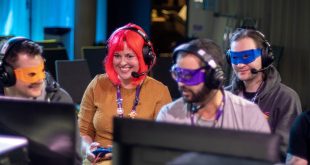 Ahead of the release of physics puzzler Poly Bridge 3, we fired over some questions to Dry Cactus technical director Alan Lawrance, hopefully to build bridges with the New Zealand developer (before our efforts inevitably tumbled into the river below).
Ahead of the release of physics puzzler Poly Bridge 3, we fired over some questions to Dry Cactus technical director Alan Lawrance, hopefully to build bridges with the New Zealand developer (before our efforts inevitably tumbled into the river below).
The Poly Bridge games are clearly wholesome and fun puzzle games, but ones that also cause you to question the world around you – such as “How sound is that rickety old bridge I’m approaching with my family in the car?” Was imbibing those kinds of thoughts always the intention?
Poly Bridge does make you more aware of bridges in the real world! This wasn’t intentional though. First and foremost, the game is meant to be fun and challenging.
Poly Bridge also rewards failure. Or, rather, it adds to the enjoyment process, oddly by not dwelling too much on the catastrophic nature of a bridge failing and people falling to their deaths. There must be a temptation though, to go all-in on that kind of spectacle and what it might add; a Poly Bridge Xtreme, if you will?
Poly Bridge games are meant for people of all ages, so we treat things like a playground rather than a realistic environment. This is also true for Poly Bridge 3. We sometimes joke around about the spectacle of the destruction that can occur. But there is no real temptation to take it further than it already is.
You’ve been making and updating these games for a number of years and there are plenty of other games that offer a similar challenge. How difficult is it to stand out amongst them?
Poly Bridge sets the standard for bridge building games. We are focused on raising the bar with each iteration, and we expect Poly Bridge 3 to do that again. Supporting and improving Poly Bridge 3 after release is also a priority. We recently had a major update for Poly Bridge 2, which was released in May 2020!

The original Poly Bridge was something of a viral hit. Is that kind of visibility just as necessary for the third game, or is the community such that you don’t have to worry too much generating that kind of interest?
Having an active and enthusiastic Poly Bridge community definitely helps with driving interest and awareness of Poly Bridge 3.
We still need to work hard on getting the word out about Poly Bridge 3.
If Poly Bridge 2 was more of a foundational renovation of the first game (physics), would it be fair to characterise the third game as more of a structural upgrade (open world, graphics)?
Poly Bridge 2 was a full rewrite of the original Poly Bridge. A custom deterministic physics engine was a huge improvement over the original, but everything else was new and improved as well. Poly Bridge 3 was able to build off the solid Poly Bridge 2 codebase, so we have been able to iterate and improve everything from the start of development.
This has allowed us to make huge improvements in the game visuals, but there are other new systems that we think players will really enjoy. One in particular is the decor system, which allows players to decorate levels with a wide variety of objects. We are looking forward to seeing how players create unique and beautiful levels with this new functionality.
Our goal with Poly Bridge sequels is to preserve the core gameplay and essence of the original, while making everything better with each new version.
What’s been the biggest challenge during the creation of Poly Bridge 3, or one that wasn’t as pressing during the development of the earlier titles? How did you overcome it?
A big challenge for Poly Bridge 3 was evolving the art style to be visually appealing while maintaining the playful and minimalistic style of the previous games. We went through many iterations of the environment, water and sky before settling on a final art style. It’s a difficult thing to achieve, and we weren’t willing to settle until we found an art style that met our standards.

There have been bridge-building games themed around Walking Dead and Portal in recent years. Was licensing an IP ever something you considered as a means to refresh the series?
This isn’t something we have considered. Poly Bridge stands on its own merits as the leader of the bridge building genre, and doesn’t need to be built around a trendy theme to be a great game.
How important is user-generated content to the success of Poly Bridge and how have you leaned into that further with the latest game?
UGC has been an important part of Poly Bridge since the original, with both the Workshop and Gallery. We are taking UGC to a whole new level with Poly Bridge 3 though. We have added built in support for modding, as well a brand new and improved in-game workshop.
Does the Poly Bridge community continually surprise and inspire you? What is the most impressive puzzle or solution that a player has submitted?
The Poly Bridge community continually amazes and inspires the team. We have an active Discord community, and we are constantly impressed with innovative creations and solutions, as well as the humour of our players. We often see creations that we never considered possible — elaborate animation using hydraulics, over-engineered bridges that seem impossibly complicated, or making the game look like Minecraft!
You love bridges, clearly. When do you think you’ll tire of them?
Hopefully never – the cool thing about Poly Bridge is there are always new things to create and discover.

 MCV/DEVELOP News, events, research and jobs from the games industry
MCV/DEVELOP News, events, research and jobs from the games industry




